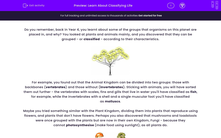Do you remember, back in Year 4, you learnt about some of the groups that organisms on this planet are placed in, and why? You looked at plants and animals mainly, and you discovered that they can be grouped - or classified - according to their characteristics.

For example, you found out that the Animal Kingdom can be divided into two groups: those with backbones (vertebrates) and those without (invertebrates). Sticking with animals, you will have sorted them out further - the vertebrates with scales, fins and gills that live in water you'll have classified as fish, for example, while the invertebrates with a shell and a single muscular foot you'll have classified as molluscs.
Maybe you tried something similar with the Plant Kingdom, dividing them into plants that reproduce using flowers, and plants that don't have flowers. Perhaps you also discovered that mushrooms and toadstools were once grouped with the plants but are now in their own Kingdom, Fungi - because they cannot photosynthesise (make food using sunlight), as all plants do.

You'll also have used keys to help you find out how the classifying process works. They're really useful when you're trying to identify an organism, helping to get it into its correct group with others of its kind. Remember, there are spider (branching) keys and 'Clue' keys, which you practised using.
So, use this activity to both revisit what you learnt previously and build on that as we explore the process of classification more deeply. Have fun!








